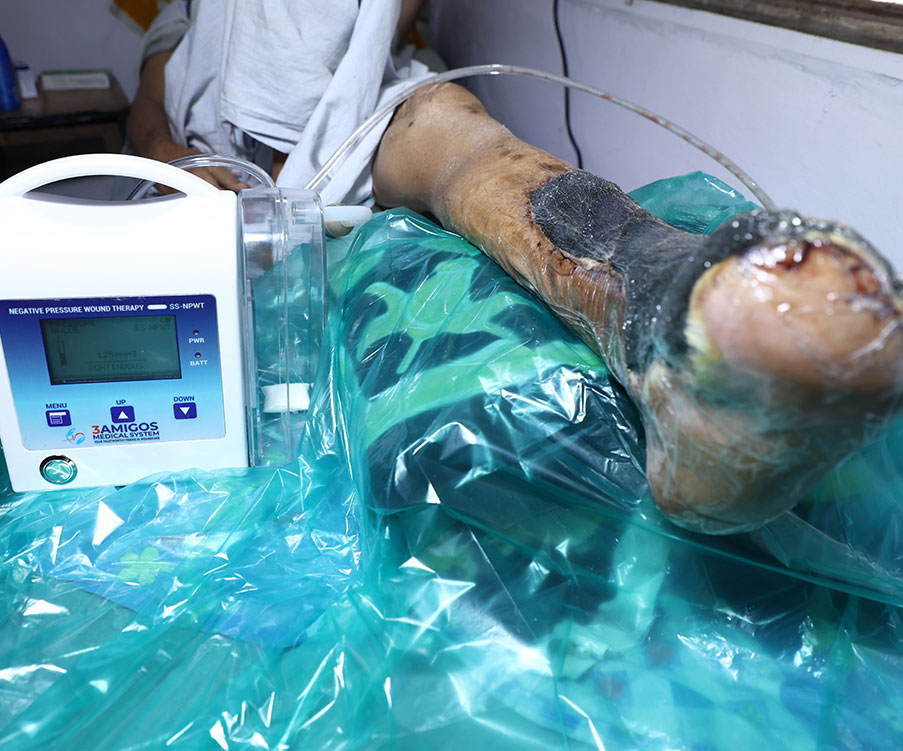In the landscape of modern wound care, the innovative approach of Negative Pressure Wound Therapy (NPWT) has revolutionized the healing process, particularly for complex wounds. This advanced technique employs a vacuum dressing system to accelerate healing, reduce complications, and ultimately enhance a patient's quality of life. If you're curious about how NPWT works, join us on this informative journey through the NPWT process, guided by 3Amigos Medical System, and discover the science behind this remarkable wound management method.

NPWT significantly aids the healing process by enhancing critical aspects of wound recovery, such as angiogenesis, endothelial proliferation, capillary blood flow, basement membrane integrity, and the reduction of edema and bacterial burden within the wound. It creates an environment conducive to effective healing.
NPWT is a versatile and powerful technique recommended for various medical conditions, including:
Despite its remarkable benefits, NPWT does have certain contraindications and warnings that should be considered to ensure safe and effective treatment.
Here’s a step-by-step explanation of how the overall process looks like -
Our NPWT journey begins with a comprehensive assessment of the wound by a skilled healthcare professional. This initial evaluation considers factors like wound size, depth, and any potential signs of infection. This crucial step sets the foundation for a tailored NPWT treatment plan designed to meet the specific needs of the patient.
Once the wound assessment is complete, the next phase involves meticulous wound preparation. This includes thorough cleansing and the removal of any damaged or necrotic tissue. With the wound primed for healing, a specialized dressing, typically crafted from polyurethane reticulated foam, is applied directly to the wound bed to create an ideal environment for recovery.
Creating an airtight seal around the wound is paramount for the success of NPWT. The dressing is securely sealed to the surrounding skin, ensuring that a sub-atmospheric pressure environment can be maintained within the wound. This sealed environment is a fundamental component of the NPWT process.
A connecting tube is then affixed to the sealed dressing, which leads to the NPWT device. This portable and battery-powered device is the heart of the NPWT process. It generates and sustains the negative pressure or vacuum within the wound, a critical element that drives the healing process.
The NPWT device springs into action, initiating the negative pressure that creates a controlled vacuum environment within the wound. This vacuum effectively draws away fluids and infectious materials, fostering a cleaner and healthier wound bed. Simultaneously, it stimulates the development of granulation tissue, a pivotal step in wound healing.
Close monitoring by healthcare professionals is integral to the NPWT process. They continuously assess the wound and the patient's response to the treatment, making necessary adjustments to the negative pressure levels for optimal results. Regular check-ups and dressing changes are part of this attentive care.
As the NPWT process unfolds, the wound heals over time. Granulation tissue forms, and the wound bed becomes primed for potential surgical closure, grafting, or other interventions. Once the wound reaches a suitable stage, NPWT may be discontinued. Throughout the healing journey, the healthcare team remains dedicated to monitoring the patient's progress.
In some instances, after completing the NPWT process, the wound is ready for closure, either through surgical means or natural tissue growth. The successful conclusion of NPWT marks the transition to wound closure and the final phases of the healing process.
Post-wound closure, the patient embarks on the road to recovery and rehabilitation. The NPWT process aims not only to accelerate wound healing but also to enhance the patient's overall quality of life.
Sustained follow-up care and support are essential for patients who have undergone NPWT. Healthcare professionals provide guidance, wound care advice, and ongoing monitoring to ensure the best possible long-term outcomes.
Embracing the incredible potential of Negative Pressure Wound Therapy (NPWT) with 3Amigos Medical System marks a significant advancement in wound care. This innovative approach leads to faster healing, fewer complications, and a profound enhancement in the patient's overall well-being. At 3Amigos Medical System, we meticulously follow these steps to ensure that patients receive the highest level of care and support. If you have any questions or wish to explore NPWT's possibilities, 3Amigos Medical System is here to guide you on your path to healing and recovery. You can reach out to us at 9820209988 or by filling out our contact form.